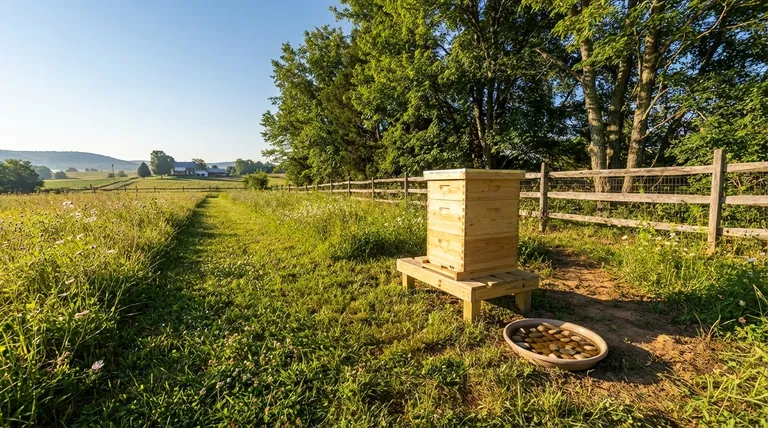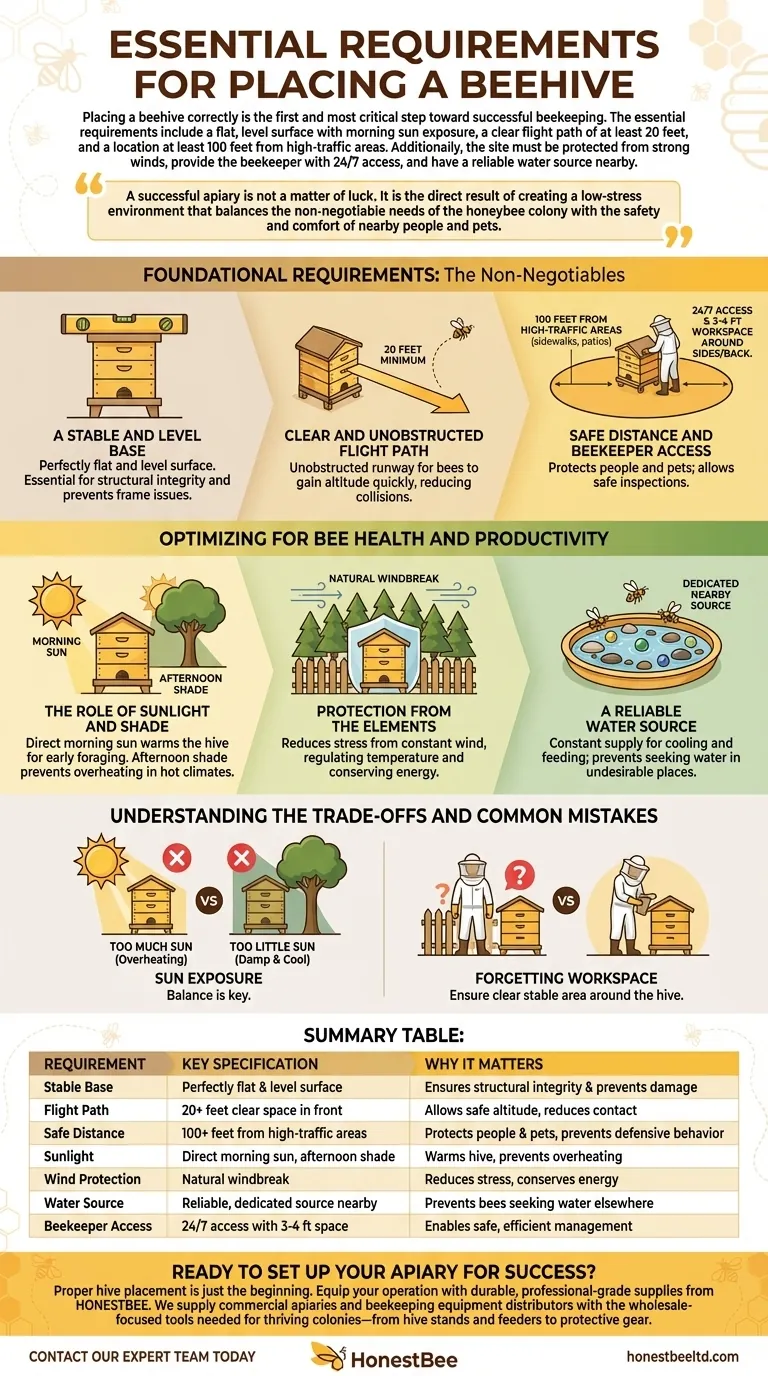Placing a beehive correctly is the first and most critical step toward successful beekeeping. The essential requirements include a flat, level surface with morning sun exposure, a clear flight path of at least 20 feet, and a location at least 100 feet from high-traffic areas. Additionally, the site must be protected from strong winds, provide the beekeeper with 24/7 access, and have a reliable water source nearby.
A successful apiary is not a matter of luck. It is the direct result of creating a low-stress environment that balances the non-negotiable needs of the honeybee colony with the safety and comfort of nearby people and pets.

Foundational Requirements: The Non-Negotiables
Before considering honey production or hive health, you must ensure the location meets basic safety and stability standards. These factors form the bedrock of a responsible apiary.
A Stable and Level Base
A beehive must sit on a perfectly flat and level surface. This is not a suggestion; it is essential for the structural integrity of the hive.
Using a carpenter's level to check the hive stand is critical. An unlevel hive can cause frames to sit incorrectly, potentially crushing bees, and makes the entire stack unstable and prone to tipping.
Clear and Unobstructed Flight Path
Bees exit and enter the hive in a direct, predictable line. You must provide an unobstructed "flight path" of at least 20 feet directly in front of the hive entrance.
A clear path acts as a runway, allowing bees to gain altitude quickly. If this path is blocked by a fence, walkway, or vegetation, bees are forced to fly at human height, increasing the chance of collisions and defensive behavior.
Safe Distance and Beekeeper Access
For the safety of people and pets, a hive should be placed at least 100 feet from any high-traffic areas. This includes sidewalks, patios, children's play areas, and neighboring properties.
Furthermore, you, the beekeeper, must have 24/7 access to the hive. You will need to approach the hive from the rear and sides for inspections and management, so ensure there is adequate working space around the entire hive.
Optimizing for Bee Health and Productivity
With the foundational requirements met, you can now focus on siting the hive to maximize the colony's health, comfort, and productivity.
The Role of Sunlight and Shade
An ideal location receives direct morning sun. This early light warms the hive, encouraging the bees to wake up and begin foraging earlier in the day.
In hotter climates, some afternoon shade is beneficial. Shade during the hottest part of the day prevents the hive from overheating, which reduces the energy bees must expend on fanning and cooling the interior.
Protection from the Elements
Constant wind is a major stressor for a honeybee colony. It can chill the hive in winter and make it difficult for returning foragers to land at the entrance.
Place your hive in a location with a natural windbreak, such as a line of trees, a hedge, or a solid fence. This helps regulate the hive's internal temperature and conserves the colony's energy.
A Reliable Water Source
Bees require a constant supply of water to cool the hive through evaporation and to dilute honey for feeding their young.
Providing a dedicated water source near the hive is crucial. This prevents your bees from seeking water in undesirable places like swimming pools, pet water bowls, or your neighbor's birdbath. A shallow dish with pebbles or marbles for the bees to land on works perfectly.
Understanding the Trade-offs and Common Mistakes
Perfect hive placement often involves balancing competing factors. Being aware of common pitfalls can save you significant trouble.
Sun Exposure: Too Much vs. Too Little
While morning sun is ideal, all-day, relentless sun can cause the hive to overheat. This forces bees to spend more time fanning and less time foraging.
Conversely, a location in deep, all-day shade will likely result in a damp, cool hive that is more susceptible to pests and less productive. The colony will be slower to start its day.
Forgetting Your Own Workspace
New beekeepers often focus only on the front of the hive. They forget that they will need to stand behind and beside the hive to lift heavy boxes, perform inspections, and manage equipment.
Ensure you have a clear, stable area of at least three to four feet around the sides and back of the hive.
Underestimating What "High-Traffic" Means
Do not interpret "high-traffic area" as just a public sidewalk. This rule applies to any place people or pets congregate, including your own deck, your driveway, or the property line you share with a close neighbor. Proactive, considerate placement prevents future conflicts.
How to Apply This to Your Project
Use these guidelines to evaluate potential sites on your property. Your specific priorities will help you make the final decision.
- If your primary focus is maximizing bee health: Prioritize morning sun, a reliable water source, and excellent protection from prevailing winds.
- If your primary focus is neighborhood harmony: Strictly adhere to the 100-foot distance rule and be proactive in providing a dedicated water source away from neighbors.
- If your primary focus is ease of management: Ensure the hive stand is perfectly level and that you have at least three feet of clear, stable workspace on all sides.
A well-chosen site is the foundation of a thriving, productive, and safe apiary.
Summary Table:
| Requirement | Key Specification | Why It Matters |
|---|---|---|
| Stable Base | Perfectly flat and level surface | Ensures hive structural integrity and prevents frame damage |
| Flight Path | At least 20 feet of clear space in front of the entrance | Allows bees to gain altitude safely, reducing human contact |
| Safe Distance | Minimum 100 feet from high-traffic areas | Protects people and pets, preventing defensive behavior |
| Sunlight | Direct morning sun, with afternoon shade in hot climates | Warms the hive for early foraging and prevents overheating |
| Wind Protection | Natural windbreak (e.g., trees, fence) | Reduces stress, conserves bee energy, and regulates hive temperature |
| Water Source | Reliable, dedicated source nearby (e.g., shallow dish with pebbles) | Prevents bees from seeking water in undesirable locations |
| Beekeeper Access | 24/7 access with 3-4 feet of clear space on all sides | Enables safe and efficient hive inspections and management |
Ready to set up your apiary for success? Proper hive placement is just the beginning. Equip your operation with durable, professional-grade supplies from HONESTBEE. We supply commercial apiaries and beekeeping equipment distributors with the wholesale-focused tools needed for thriving colonies—from hive stands and feeders to protective gear.
Contact our expert team today to discuss your specific needs and discover how our bulk solutions can support your beekeeping goals.
Visual Guide

Related Products
- Langstroth Honey Bee Box Hive Boxes for Different Depths
- Professional Galvanized Hive Strap with Secure Locking Buckle for Beekeeping
- Heavy-Duty Nylon Beehive Hive Strap with Stainless Steel Cinch Buckle
- Versatile Ratchet Hive Strap with S-Hooks for Secure Fastening
- Professional Reversible Beehive Hive Entrance
People Also Ask
- How should hive boxes be aligned after reassembly? Ensure a Perfect Seal for Hive Health
- How does a hive box work? A Guide to the Langstroth Hive System for Beekeepers
- What is the best time to inspect a hive? Optimize for Bee and Beekeeper Safety
- How deep is a medium bee box? Unlock the Key to a Versatile and Manageable Hive
- What are the sizes of supers available in a standard hive? A Guide to Deep, Medium, and Shallow Boxes



















